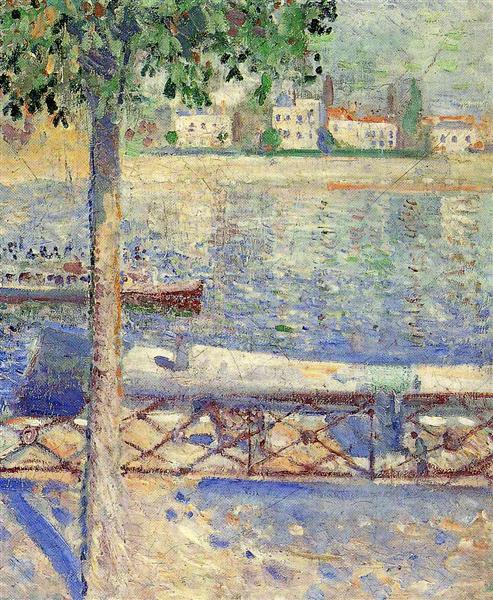Description
The painting "Vista on the Rover in St. Cloud" (1890) by Edvard Munch is a work that captures the essence of European landscaping of the late nineteenth century, while emanating the introspective and emotional character that would characterize the production of the artist Norwegian in his training years. This painting It shows a contemplative landscape where nature becomes a mirror of the internal states of the human being, a recurring theme in Munch's work.
The composition of the paint focuses on the representation of the river, which winds through the pictorial space, guiding the viewer's gaze towards the horizon. The use of space is remarkable: the river acts as an axis that connects the different elements of the painting, creating a visual narrative that invites a contemplative trip. In the foreground, vegetation stripes are observed that suggest a vibrant and dynamic landscape, while in the distance there are soft hills and a mist atmosphere that confers an air of mystery to the scene. This use of space and depth suggests a fusion between the natural world and the emotional world of human characters, which, although they are not visible in this landscape, are implicitly present in the atmosphere of melancholy and reflection.
The treatment of color in "View about Rover in St. Cloud" is essential to understand Munch's intention. Its dominant blue and green tones are combined with Terracota and Ocrious nuances, creating a palette that evokes both tranquility and introspection. Light seems to filter subtle, contributing to the scene an almost dreamlike quality. This chromatic approach not only enhances the beauty of the landscape, but can also be interpreted as a representation of moods, where shadows and lights dialogue in a poetic way.
Edvard Munch, known for his ability to capture human anguish and passion in his works, addresses in this painting a theme that transcends simple visual representation. Although in this specific work there are no human figures, the absence of characters can be interpreted as a comment on loneliness and isolation to the vastness of nature. This concept is recurring in the symbolism that Munch used in his career, where the connection between the individual and his environment resonates intensely.
The work is also located within the artistic evolution of Munch, a movement that flirts with symbolism and post -impressionism. His search for emotion through color and shape is reflected here, anticipating the developments of his career and his subsequent consecration as a fundamental figure of expressionism. Although "seen on the rover in St. Cloud" may not be as well known as "the cry" or "the Madonna", it stands as a significant piece that establishes a bridge between naturalistic observation and emotional expression, characteristics that would define its subsequent work.
As the viewer immerses himself in this work, he feels invited not only to observe the landscape, but to experience the complex interrelation between nature and human experience. This unique approach makes "view of the rover in St. Cloud" into a work that, despite its apparent simplicity, offers deep reflections on existence and perception. Munch, through this painting, confronts us with beauty and melancholy that accompany the moments of contemplation, turning a mere landscape into a space of deep introspection and emotional connection.
KUADROS ©, a famous paint on your wall.
Hand-made oil painting reproductions, with the quality of professional artists and the distinctive seal of KUADROS ©.
Art reproduction service with satisfaction guarantee. If you are not completely satisfied with the replica of your painting, we refund your money 100%.

